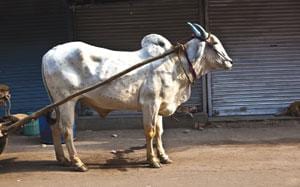
No Delhi street scene is complete without a sacred cow or bull. Credit: iStockphoto/Thinkstock
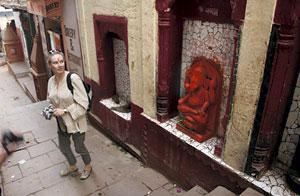
Ganesha, India's most widely worshipped deity, is revered as the "remover of obstacles." Shrines and effigies are found on virtually every block and above every doorway. Credit: Thomas Roth
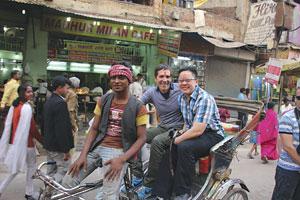
A rickshaw ride is the best way to experience Delhi's splendour. Credit: Thomas Roth
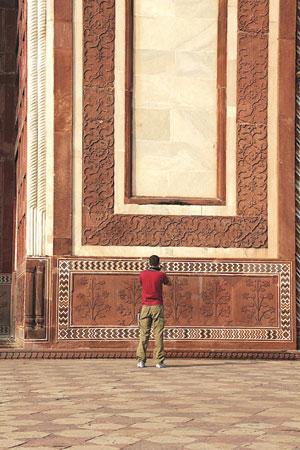
An intricately carved wall mural in the Mogul style. Credit: Thomas Roth
Delhi is one of the largest and fastest-growing cities in the world. Bursting at the seams, it teems with sights, sounds and smells; its vibrancy and cultural diversity radiate from every street scene. There are architectural marvels, colourful shops, delicious food, wonderful people and the ever-present throng intermingled with sacred cows and stray dogs. It is a place rich in history and steeped in contrasts: old and new, aromatic and smelly, pristine and grimy.
New Delhi, India’s capital, lies at the centre of the metropolis of Delhi. The best way to get around New Delhi is by rickshaw or tuk-tuk (motorized rickshaw). The passenger experience can be a little hair-raising initially, but it’s richer than being sealed up in a car.
Even if you’re not an architecture or history nut, a tour of the city’s buildings is a must. The Lotus Temple, Humayun’s Tomb, the temples of Akshardham and Laxminarayan, and the India Gate are not to be missed, but Delhi’s architectural jewel is the Rashtrapati Bhavan (Sanskrit for Presidential House), the largest chief-of-state residence in the world. Flanked by Parliament House and the Secretariat, the complex is enormous. Just up the street is the Bungalow Zone: street after street of British Raj–era mini palaces with magnificent gardens. For high-end shopping and dining, visit Connaught Place, where aficionados of art and history will find several world-class museums and galleries.
Just north of New Delhi is the walled city of Old Delhi. Although much of the wall has been lost, the magnificent entry gates still stand. At the centre of Old Delhi is the Red Fort, a 17th-century palace fortress. Don’t miss the nearby Jama Masjid, India’s largest mosque. Wander the street bazaars of Old Delhi on foot for a rich shopping experience.
The gay scene
You won’t find a gay district or village in Delhi, but there are regular gay nights at various locations across the city. Listings for gay spaces and events can be found online, but one of the best ways to be in the know is to ask the locals. Tuesday nights at Pepper in South Delhi’s Chanakyapuri neighbourhood is a good place to start. Guys can also find cruising and meeting-place listings, and connect with gay Delhiwallas, at squirt.org.
Travel tips
The warm sunny days, cool nights and foggy mornings between November and April represent the best weather window for your visit. May and June are hot and sticky, with the monsoon season beginning to recede in early October.
Foreign nationals entering India need travel visas. Getting them can take a while, so plan ahead. Check with your Indian consulate for forms and procedures. See your doctor at least a month before you go to ensure your vaccinations are up to date.
Shorts and T-shirts are not culturally appropriate in India. Walking around in public in a tank top is like walking around in your underpants. You won’t get ticketed, but you may be turned away from some attractions and businesses, and you will get strange looks. Wear long pants and light shirts. And take a light jacket for the cool mornings and evenings if you’re travelling in winter.
A 10 percent gratuity is customary for waiters, guides and service providers. Fifty rupees is standard for bellboys, luggage handlers and general service staff.
Avoiding Delhi Belly is not difficult if you avoid ice cubes and use bottled water for drinking and tooth brushing. Stay away from milk and uncooked dairy products, and choose raw fruits and vegetables you peel yourself. Consider forgoing meat; vegetarian dishes are common and very tasty.
Getting there
Virtually every major air carrier offers regular service to Delhi, but the trip is a long haul from Canada, so choose your airline carefully. Indira Gandhi International Airport is modern and reasonably easy to navigate. It’s 20 kilometres from the city centre, but ground travel can be very slow because of traffic, so plan accordingly.
Delhi’s efficient transit system includes both rail and bus service to the city centre. Taxi and car rental information is on the airport’s website. For rail information, go to the Delhi Metro website (delhimetrorail.com). For bus schedules and information, search online for the Delhi Transport Corporation (delhi.gov.in/wps/wcm/connect/DOIT_DTC/dtc/home).
Getting around
Public transit by rail and bus systems in Delhi is efficient and inexpensive and will likely get you where you need to go.
Taxi fares are paid in advance and depend on how much baggage you have and how far you’re going. It’s best to avoid unlicensed taxis, but state-regulated booths are easy to find. The Delhi Traffic Police website has specific information and booth locations.
Hiring a car for the day is a comfortable, hassle-free way to get around, and drivers can be great sources of information. Ask the concierge at your hotel for arrangements, and plan to spend $40 to $50 for the day.
Tuk-tuks and rickshaws are available on most every street corner and at most monuments and public spaces. Just be sure to set a price before you get in. Short tuk-tuk trips will cost around 20 rupees; 100 rupees should get you across the city. Rickshaws are more plentiful in Old Delhi; expect to pay 20 rupees for an average ride or 100 rupees for a nice tour of Old Delhi.
For map locations and website links to two dozen area places of interest see our gay New Delhi listings pages.
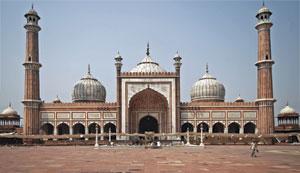
 Why you can trust Xtra
Why you can trust Xtra